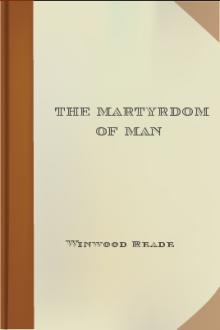The Martyrdom of Man by Winwood Reade (mini ebook reader .TXT) 📕

- Author: Winwood Reade
- Performer: -
Book online «The Martyrdom of Man by Winwood Reade (mini ebook reader .TXT) 📕». Author Winwood Reade
became with young.
In water there are always floating about a multitude of specks
which are usually minute fragments of the soil. But now
appeared certain specks which, though they resembled the
others, possessed certain properties of a very peculiar kind.
First, they brought forth little specks, precise copies of
themselves: they issued their own duplicates. And secondly,
they performed in their own persons an elaborate chemical
operation. Imbibing water and air, they manufactured those
elements with the assistance of the solar rays, into the
compounds of which their own bodies were composed, giving back
to the water those components which they did not require. And
then appeared other little specks which swallowed up the first,
and manufactured them into the compounds more complex still, of
which they, the second comers, were composed. The first were
embryonic plants; the second were embryonic animals. They were
both alike in appearance; both repeated themselves, or
reproduced, in the same manner. The difference between them was
this, that the plants could live on raw air and water, the
animals could live only on those elements when prepared by sun
light in the body of the plant. The office of vegetation upon
the earth is therefore of a culinary nature, and the plant,
when devoured, gives the animal that heat which is its life,
just as coal (a cake of fossil vegetation) gives heat to the
apartment in which it is consumed. But this heat, whether it
lies hidden in the green and growing plant, or in its black and
stony corpse, was at first acquired from the sun. Glorious
Apollo is the parent of us all. Animal heat is solar heat; a
blush is a stray sunbeam; Life is bottled sunshine, and Death
the silent-footed butler who draws out the cork.
Those dots of animated jelly, without definite form or figure,
swimming unconsciously in the primeval sea, were the ancestors
of man. The history of our race begins with them, and continues
without an interruption to the present day; a splendid
narrative, the materials of which it is for science to
discover, the glories of which it is for poets to portray.
Owing to the action of surrounding forces, the outer parts of
the original jelly-dot became harder and more solid than the
parts within, and so it assumed the shape of the cell or
sphere. Its food consisted of microscopic fragments of
vegetable matter imbibed through its surface or outer rind,
such portions as were not “made up” being expelled or excreted
in the same manner as they were taken in. There was no
difference of parts, except that the outside was solid and the
inside soft. The creature’s body was its hand, its stomach, and
its mouth. When it had lived a certain time it burst and died,
liberating, as it did so, a brood of cells which had slowly
ripened within. But sometimes these new cells, instead of being
detached when they were born, remained cohering to the parent
cell, thus making the animal consist of several cells instead
of only one. In the first case the process is termed
reproduction; in the second case it is termed growth. But the
two operations are in reality the same. Growth is coherent
reproduction; reproduction is detached growth.
Time goes on. Our animal is now a cell-republic enclosed by a
wrapper of solidified and altered cells. Next, in this wrapper
a further change takes place. It protrudes into limbs; a gaping
month appears. The limbs or tentacles grasp the food and put it
within the mouth; other limbs sprout forth and carry their
owner from place to place. In the meantime the cells within are
also changed; their partitions are removed; the many-walled
apartments are converted into galleries or tubes, along which
the food is conveyed from one part of the body to another.
These tubes are filled with blood, pumped backwards and
forwards by the heart. The muscles which move the outer limbs
are equipped with nerves, the movements of which are directed
from centres in the spine and brain. The functions of life are
thus divided, and each department has an organ of its own. The
reproductive function is divided farther still. Two separate
elements are formed; one prepares and ejects the sperm-cell
which the other receives, and unites to the germ-cell. At a
later period in the history of life this arrangement is
supplanted by another, more complicated still. The two elements
no longer co-exist in the same form, and thus reproduction can
only be effected by means of co-operation between two distinct
and independent individuals. How important a fact is this will
presently appear.
These various inventions of Nature, so far as we have gone; the
limbs of locomotion and prehension; the heart with its vessels;
the brain with its nerves; and the separation of the sexes, all
occurred in the marine period of the earth’s life: in the dark
deep sea womb.
Similar changes, but inferior in degree, occurred in the
vegetable world. The shapeless specks became one-celled: they
were next strung together like a chain of beads; they then grew
into seaweed and aqueous plants, which floated about, and
finally obtained a footing on the land. But they dwelt long
ages on the earth before their sex appeared. There were no
flowers in that primeval world, for the flower is a sign of
love. Gigantic mosses and tree ferns clothed the earth, and
reproduced themselves by scattering cells around.
Animals followed their prey, the plants, from the water to the
land and became adapted for terrestrial life. At that period
the atmosphere was thickened with carbonic acid gas, and was
more pestilential than the Black Hole of Calcutta. Only
reptiles, with sluggish and imperfect respiratory organs, could
breathe in such an air. But that fatal gas was bread to the
vegetable world, which took the carbon into its body, and thus
the atmosphere was purified in time. The vast masses of carbon
which the plants took out of the air in order to allow a higher
class of animal to appear upon the stage, were buried in the
earth, hardened into coal, and were brought in by the Author in
the second act — now on.
The coal-matter being thus removed, the air was bright and
pure; the sun glowed with radiance and force; the reptiles were
converted into birds and quadrupeds of many kinds; insects
rising from the land and from the water hummed and sparkled in
the air; the forests were adorned with flowers, and cheered
with song. And as the periods rolled on, the inhabitants of the
earth became more complex in their structure, more symmetrical
in form, and more advanced in mental power, till at last the
future lord of the planet himself appeared upon the stage. The
first act of the drama is here concluded: but the division is
merely artificial; in Nature there is no entr’acte; no curtain
falls. Her scenes resemble dissolving views; the lower animals
pass into man by soft, slow, insensible gradations.
We must now consider the question, How and why have these
marvellous changes taken place? How and why did the primeval
jelly-dots assume the form of the cell or sphere?
It has been already shown that continual changes occurred in
the primeval atmosphere and in the primeval sea. These changes
acting upon animal life produced changes in its composition.
For as animals are the result and expression of the conditions
under which they are born, it is natural to suppose that when
these conditions are changed, the animals should also change.
When the conditions of life are abruptly altered and
instantaneously transformed, the animals are of course
destroyed; but when, as is usually the case, the changes are
gradual, the animals are slowly modified into harmony with the
neighbouring conditions. The primeval speck of life being acted
upon by a variety of forces, became varied in its structure and
as these forces varied from period to period, the organisms
also varied. Complexity of parts results from complexity of
environment. Multiformity of circumstance produces multiformity
of species. The development of animal life from the homogeneous
to the heterogeneous, from the simple to the complex, from
uniformity to multiformity, is caused by the development of the
earth itself from a monotonous water-covered globe with one
aspect, one constitution, and one temperature to this varied
earth on which we dwell, where each foot of land differs in
some respect from the one beside it. The modifications on
modifications of the animal are due to the modifications on
modifications of the medium in which and on which it lived. And
this operation of Nature is hastened and facilitated by a law
which in itself is murderous and cruel. The earth is overpopulated upon principle. Of the animals that are born, a few
only can survive. There is not enough food for all; Nature
scrambles what there is among the crowd. If any animal
possesses an advantage, however slight, over those with whom he
competes in this food-scramble or struggle for existence, he
will certainly survive; and if he survives, then some one else,
so gentle Nature orders it, must die. This law of competition
becomes itself a force by developing slight variations along
lines of utility into widely different and specific forms.
But how is it that animals of the higher type prevail? Why
should species, with a tendency towards a complicated
structure, generally triumph over simple forms? The reason
appears to be this, that whenever a change takes place, it is
almost invariably a change towards complexity. Now it is an
ascertained law that animals are invigorated by a slight
change; they are therefore improved by an approach towards
complexity. Let us take the most mysterious of all progressive
operations — the division of the sexes. The hermaphrodite can
fertilise itself, but its organs are so arranged that it can be
fertilised by another individual, the wind or the water acting
as the go-between. The offspring of such separate unions are
always more vigorous than the home-born progeny of the
hermaphrodite. The latter are therefore killed off by means of
the struggle for existence, and sexual union, at first the
exception, becomes the rule. Just as a body of artisans can do
more work and better work when each man devotes his whole life
to a single department of the craft, so it is good for the
animal that division of labour should be established in its
structure; that instead of the creature being its own mouth,
its own stomach, its own organ of excretion, reproduction, and
locomotion, it should be divided into separate parts, one of
which moves it, another part takes the food, another part
chews, another part digests, another part prepares the blood,
another part pumps the blood to and fro, another part
reproduces the species, another part nourishes the young, while
over all presides the brain.
But how is it that some animals have progressed while others
have remained at the bottom of the scale, and others again have
advanced only to a certain point? If all have grown out of such
specks of animated jelly as are still to be found within the
sea, how is it that some have remained throughout infinite
periods of time unchanged; that others have remained in the
form of the sponge, rooted upon rocks; that others, like the
lobster, have never exchanged their jointed bodies for the more
perfect skeleton of the fish; that some fish have taken to the
land, and have been converted into reptiles, and then into
birds or quadrupeds, while others have remained in the aqueous
condition; and lastly, that one animal, namely Man, has
contrived to distance all the others when, as it is
acknowledged, they all started fair?
In reply, let me ask those who admit the development of all
civilised people from the savage





Comments (0)